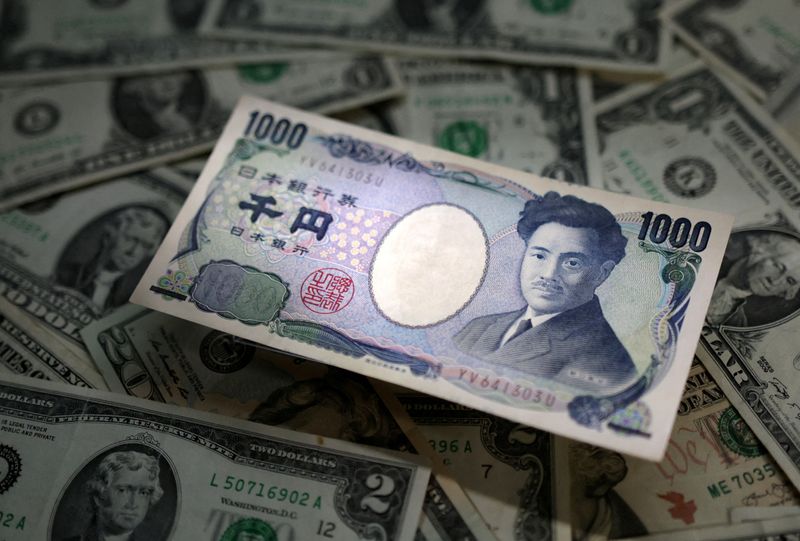Yen eyes best week in four months, dollar heads for weekly decline
2023.11.16 20:36

© Reuters. FILE PHOTO: Japanese Yen and U.S. dollar banknotes are seen in this illustration taken March 10, 2023. REUTERS/Dado Ruvic/Illustration
By Rae Wee
SINGAPORE (Reuters) – The yen was on track for its best week against the dollar in four months on Friday on the prospect of a narrowing U.S.-Japan rate differential, with bets that the Federal Reserve is done raising rates leaving the greenback headed for a weekly loss.
A slew of weaker-than-expected U.S. economic data released this week, led by a slowdown in inflation, has reinforced market expectations that the Fed has reached the end of its aggressive monetary tightening cycle, with focus now on when the first rate cuts could begin.
Market pricing shows just a 0.3% chance of another rate hike in December, as compared to a roughly 15% chance a week ago, with a 35% chance that the U.S. central bank could begin easing monetary conditions as early as next March, according to the CME FedWatch tool.
That’s led to a decline in U.S. Treasury yields alongside a fall in the dollar, which was on track to lose nearly 0.6% on the yen for the week, its worst weekly performance since July.
Against the greenback, the euro and sterling were likewise eyeing a weekly jump of more than 1.5% each, while the was on track to lose 1.3%.
The euro steadied at $1.0851, while sterling last bought $1.2412.
“The market reaction to the (U.S.) CPI was very substantial given that the inflation miss was only quite small, and that’s a bad sign for the dollar going forward,” said Sean Callow, a senior currency strategist at Westpac.
“It might set up a narrative whereby the markets start talking about the FOMC statement in December as not only being rates on hold but… that they might go to a more neutral stance.”
Separate data released this week showed U.S. retail sales fell for the first time in seven months in October, while signs of a cooling U.S. labour market continue to build as the number of Americans filing new claims for unemployment benefits increased to a three-month high last week.
The Japanese yen last stood at 150.72 per dollar, remaining on the weaker side of the 150 threshold and not far from Monday’s one-year low of 151.92 per dollar.
Despite a possible peak in U.S. rates and even as insiders believe the Bank of Japan (BOJ) is priming markets for an end to negative interest rates, the wide gap between Japan’s ultra-low rates and those in the United States continues to keep the yen under pressure.
“I think (the BOJ) is still going to err on the cautious side. It’s our house view that they don’t touch policy settings for many, many months, so deep into next year,” said Callow.
“If that’s the case, then yes, the U.S. dollar will probably have less yield appeal, but we don’t think it’s enough to really turn the tide — the gap is just still so wide.”
Elsewhere, the Australian and New Zealand dollars were likewise eyeing weekly gains of 1.7% and 1.3%, respectively, helped by the slide in the greenback.
The was last 0.08% lower at $0.6466, having showed little reaction to upbeat Australian jobs data released in the previous session.
The fell 0.14% to $0.5963.








